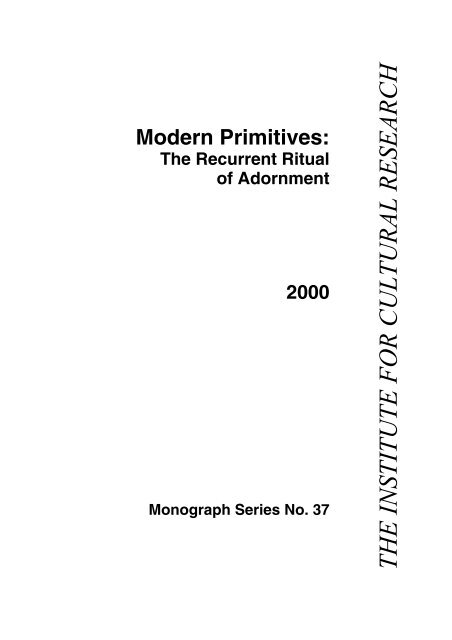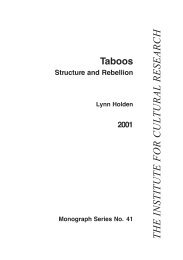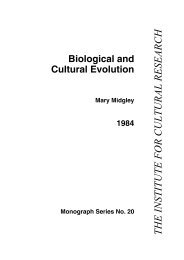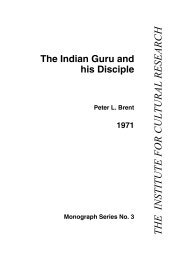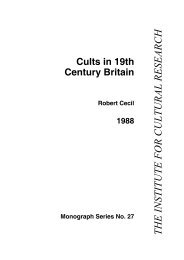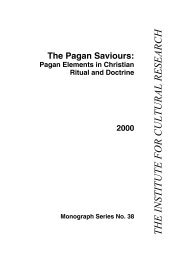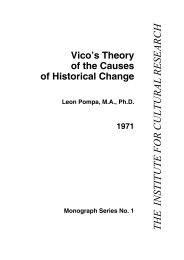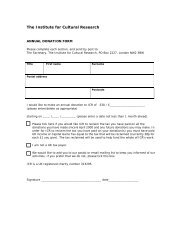Modern Primitives: the recurrent ritual of adornment
Modern Primitives: the recurrent ritual of adornment
Modern Primitives: the recurrent ritual of adornment
Create successful ePaper yourself
Turn your PDF publications into a flip-book with our unique Google optimized e-Paper software.
<strong>Modern</strong> <strong>Primitives</strong>:<br />
The Recurrent Ritual<br />
<strong>of</strong> Adornment<br />
2000<br />
Monograph Series No. 37<br />
THE INSTITUTE FOR CULTURAL RESEARCH
Copyright © 2000 Cultural Research Services<br />
The right <strong>of</strong> Cultural Research Services to be identified as <strong>the</strong> owners <strong>of</strong><br />
this work has been asserted by <strong>the</strong>m in accordance with <strong>the</strong> Copyright,<br />
Designs and Patents Act 1988.<br />
All rights reserved<br />
Copyright throughout <strong>the</strong> world<br />
No part <strong>of</strong> this publication may be reproduced or transmitted in any form or<br />
by any means, electronic, mechanical or photographic, by recording or any<br />
information storage or retrieval system or method now known or to be<br />
invented or adapted without prior permission obtained in writing from <strong>the</strong><br />
publisher, <strong>the</strong> Institute for Cultural Research, except by a reviewer quoting<br />
brief passages in a review written for inclusion in a journal, magazine,<br />
newspaper or broadcast.<br />
Requests for permission to reprint, reproduce, etc. to:<br />
The Institute for Cultural Research, PO Box 2227, London NW2 3BW<br />
Monograph Series No. 37<br />
This version prepared for free download 2006.<br />
The original hard copy edition:<br />
ISSN 0306 1906 – ISBN 0 904674 29 0 – Published 2000<br />
may be purchased from <strong>the</strong> address given above, or on <strong>the</strong> ICR website,<br />
www.i-c-r.org.uk<br />
2
MODERN PRIMITIVES<br />
The Recurrent Ritual <strong>of</strong> Adornment<br />
‘In all ages, far back into pre-history, we find human beings have<br />
painted and adorned <strong>the</strong>mselves.’<br />
H.G. Wells, The Work, Wealth and Happiness <strong>of</strong> Mankind<br />
Self-ornament and skin decoration are probably among <strong>the</strong> oldest examples<br />
<strong>of</strong> enduring human <strong>ritual</strong>. In prehistoric times <strong>the</strong>y served various ends:<br />
promoting hunting magic, storing and transmitting mythological lore and<br />
forging tribal identity.<br />
Today, we have moved beyond <strong>the</strong> hunter-ga<strong>the</strong>rer society, but <strong>the</strong> urge<br />
for skin ornamentation is undergoing a revival. Today’s ‘modern primitives’<br />
use tattoos, piercings and o<strong>the</strong>r forms <strong>of</strong> skin design to perform almost<br />
exactly <strong>the</strong> same functions as that <strong>of</strong> our ancestors: <strong>the</strong>y use <strong>the</strong>m to forge<br />
‘tribal’ affiliations – and within that circle <strong>the</strong>y have come to represent a<br />
collective common language and set <strong>of</strong> aes<strong>the</strong>tic values. They may even<br />
represent superstitious or magical belief. More curious still, <strong>the</strong>y do so not<br />
in <strong>the</strong> rain forest, but in <strong>the</strong> concrete jungles <strong>of</strong> our inner cities.<br />
So, what are <strong>the</strong> reasons behind this revival? Why should <strong>the</strong>re be a<br />
need to return to such an archaic-seeming, and to many people distasteful<br />
<strong>ritual</strong>? What do its proponents get out <strong>of</strong> it? Examining <strong>the</strong> structure <strong>of</strong> this<br />
extraordinary phenomenon may help us to understand more about <strong>the</strong><br />
reasons behind our seemingly baffling need for <strong>ritual</strong>.<br />
At <strong>the</strong> same time that <strong>the</strong> ‘modern primitives’ in our cities adorn<br />
<strong>the</strong>mselves, we can also see <strong>the</strong> unbroken continuation <strong>of</strong> body modifying<br />
<strong>ritual</strong> in traditional tribal groupings around <strong>the</strong> world. For <strong>the</strong>se groups it<br />
<strong>of</strong>ten serves to bond <strong>the</strong> individual to <strong>the</strong> majority culture. In industrialised<br />
societies, on <strong>the</strong> o<strong>the</strong>r hand, such body ornament – <strong>of</strong>ten seen as mutilation<br />
– has come to represent a rebellion against, ra<strong>the</strong>r than an embodiment <strong>of</strong>,<br />
dominant cultural values. Ritual body modifications – such as piercing,<br />
scarification, branding and multiple tattoos – are <strong>of</strong>ten used by <strong>the</strong> ‘modern<br />
primitives’ to repudiate <strong>the</strong> mainstream culture <strong>of</strong> industrialised society <strong>the</strong>y<br />
feel powerless to control.<br />
Body modification has, over <strong>the</strong> centuries, been discovered and<br />
rediscovered by a wide range <strong>of</strong> societies. The Romans, for example,<br />
engaged in piercing, with many centurions wearing nipple rings as a sign <strong>of</strong><br />
courage and virility. The Ancient Egyptians wore navel jewellery to denote<br />
3
nobility. In addition to appropriating <strong>ritual</strong> piercing from past ages for <strong>the</strong>ir<br />
own use, <strong>Modern</strong> <strong>Primitives</strong> have been indirectly responsible for <strong>the</strong> <strong>ritual</strong>’s<br />
rising popularity in mainstream culture.<br />
Since <strong>the</strong> birth <strong>of</strong> <strong>Modern</strong> Primitivism in <strong>the</strong> late 1970s, piercing has<br />
become increasingly evident in <strong>the</strong> Western world, with pierced navels and<br />
nostrils on show in mainstream fashion magazines and on <strong>the</strong> catwalks in<br />
Europe and <strong>the</strong> United States. This mainstream adoption <strong>of</strong> body jewellery,<br />
which was originally intended as a form <strong>of</strong> rebellion and forging a<br />
distinctive identity, has pushed <strong>Modern</strong> <strong>Primitives</strong> towards increasingly<br />
extreme forms <strong>of</strong> piercing.<br />
Ano<strong>the</strong>r decorative technique that <strong>the</strong> <strong>Modern</strong> <strong>Primitives</strong> favour<br />
tattooing – has also been used since early times. For example,<br />
archaeologists have found tattoos on Egyptian mummies, and recently<br />
discovered <strong>the</strong> remains <strong>of</strong> a 5,300-year-old man in Austria with a line<br />
tattooed on his back and a cross tattooed behind one knee.<br />
Throughout <strong>the</strong> ages, skin decorations – which get <strong>the</strong>ir name from <strong>the</strong><br />
Tahitian root ‘tattoo’, meaning to inflict wounds – have been favoured by<br />
royalty and warriors alike. King Harold, killed at <strong>the</strong> Battle <strong>of</strong> Hastings, had<br />
‘Edith’ tattooed over his heart, and tattoos have been inscribed on monarchs<br />
from Denmark’s Frederick IX to Russia’s Tsar Nicholas II. In <strong>the</strong> Far East,<br />
people continue to use tattoos as magical tokens to ward <strong>of</strong>f evil and to<br />
denote allegiance.<br />
The art fell into disrepute in <strong>the</strong> West when it begun to be used to mark<br />
criminals, slaves and misfits, only to become fashionable once again in <strong>the</strong><br />
late 1800s, when high-society ladies were seized by a passion for dainty<br />
skin art. Among <strong>the</strong>m was Winston Churchill’s mo<strong>the</strong>r, Lady Randolph<br />
Churchill, who had a small coiled snake tattooed around one wrist.<br />
Like piercing, tattoos are now becoming commonplace. Today, <strong>the</strong>y<br />
decorate <strong>the</strong> skins <strong>of</strong> stars <strong>of</strong> <strong>the</strong> music world, catwalks and silver screen,<br />
and tattoo artists have <strong>the</strong>ir own trade fairs and vie for first place in<br />
international competitions. Like piercing, <strong>the</strong> small, aes<strong>the</strong>tic designs<br />
appropriated by <strong>the</strong> mainstream are no longer sufficient for <strong>Modern</strong><br />
Primitivism. Instead, <strong>the</strong> movement has swept away concealed or intimate<br />
designs, replacing <strong>the</strong>m with a patchwork <strong>of</strong> images. In <strong>the</strong> drive to remain<br />
socially unacceptable, <strong>the</strong> whole body becomes a picture gallery, and <strong>the</strong><br />
idea <strong>of</strong> <strong>the</strong> tattoo turns away from a badge or sticker on one small site,<br />
towards what <strong>Modern</strong> <strong>Primitives</strong> call ‘a full body concept’.<br />
The modish use <strong>of</strong> piercing and tattoos has also encouraged <strong>Modern</strong><br />
<strong>Primitives</strong> to look for alternative forms <strong>of</strong> body art, like scarification and<br />
branding. In scarification, <strong>the</strong> pain <strong>of</strong> <strong>the</strong> process (it involves <strong>the</strong> cutting <strong>of</strong><br />
<strong>the</strong> skin with a scalpel) is part <strong>of</strong> <strong>the</strong> attraction. Very like <strong>the</strong> initiation<br />
4
ceremonies in tribal societies, <strong>the</strong> aim is to create a common bond,<br />
within an exclusive society. To mark <strong>the</strong> rite <strong>of</strong> passage, blood-prints<br />
are <strong>of</strong>ten taken from <strong>the</strong> cuts. The scars, as <strong>the</strong> trophies <strong>of</strong> <strong>the</strong> pain<br />
endured – and hence a badge <strong>of</strong> admittance to a select club – are <strong>of</strong>ten<br />
deliberately intensified.<br />
The parallels with tribal cultures are plain. In <strong>the</strong>se societies,<br />
scarification is <strong>of</strong>ten closely associated with rites <strong>of</strong> passage and with magic.<br />
The Aborigines used <strong>the</strong> markings to show that youngsters had learned <strong>the</strong><br />
tribal magic lore. Indian Sadhu males use <strong>ritual</strong> cutting as one <strong>of</strong> a variety<br />
<strong>of</strong> techniques to induce a trance state.<br />
Reasons for body modification<br />
The reasons given by <strong>Modern</strong> <strong>Primitives</strong> for permanently altering <strong>the</strong>ir<br />
bodies through piercing, scarification, branding and tattooing appear to fall<br />
into twelve principal categories. These are:<br />
1. Rituals associated with rites <strong>of</strong> passage<br />
2. The creation <strong>of</strong> a lifelong bond with o<strong>the</strong>rs<br />
3. As a sign <strong>of</strong> respect for elders<br />
4. As a symbol <strong>of</strong> status or courage<br />
5. Mysticism or magic<br />
6. Protection against evil spirits<br />
7. The opening <strong>of</strong> channels between an individual and spirits or energies<br />
8. Rebalancing <strong>the</strong> body<br />
9. Physical healing<br />
10. Emotional healing<br />
11. Group or tribal healing<br />
12. Tribal or group connection to greater forces, especially during times<br />
<strong>of</strong> disaster<br />
These are reasons <strong>the</strong>y appear to share with many tribal peoples around<br />
<strong>the</strong> world.<br />
Rites <strong>of</strong> passage<br />
In New Guinea, for example, <strong>the</strong> Roro people are extensively tattooed. The<br />
skin decorations are so widely practised that <strong>the</strong>y describe <strong>the</strong> un-tattooed<br />
person as ‘raw’, comparing him to uncooked meat.<br />
5
‘The Roro see <strong>the</strong> tattooed man as ‘cooked meat’, transformed by a<br />
human process, and thus given a social identity. Therein lies <strong>the</strong><br />
distinction between a social being and a biological entity.’<br />
Victoria Ebin, The Body Decorated<br />
<strong>Modern</strong> <strong>Primitives</strong> claim to use body modification in or to achieve a<br />
similar goal. Jane, for example, started stretching <strong>the</strong> holes in her earlobes<br />
when she was seventeen. The stretching coincided with her leaving her<br />
birthplace, Manchester, and moving to London. Several years later, <strong>the</strong><br />
holes are sufficiently enlarged for her to insert a bottle cork through her<br />
lobes. She judges her personal progress, and <strong>the</strong> development <strong>of</strong> her life in<br />
London, according to <strong>the</strong> extended holes, saying <strong>the</strong>y remind her just how<br />
far she has come.<br />
In tribal cultures <strong>the</strong> world over, each stage <strong>of</strong> a person’s life is recorded<br />
by body decoration <strong>of</strong> one kind or ano<strong>the</strong>r. In many African societies, life<br />
development has traditionally been etched out on <strong>the</strong> body in a complex and<br />
ever updated pattern <strong>of</strong> delicate scars. For girls, life achievements such as<br />
<strong>the</strong> first menstruation, marriage and first childbirth were most <strong>of</strong>ten<br />
recorded. For boys puberty and <strong>the</strong> first kill in battle or <strong>the</strong> hunt were<br />
important milestones.<br />
The fact that tribal markings continue to be practised despite having<br />
been banned by most governments testifies to <strong>the</strong> enormous importance<br />
placed in permanently recording rites <strong>of</strong> passage.<br />
Ga’anda women <strong>of</strong> Nigeria undergo scarring from around <strong>the</strong> age <strong>of</strong><br />
five. Over several years, an intricate pattern is made up according to<br />
traditional lines. The first scars are made on <strong>the</strong> stomach, followed by those<br />
on <strong>the</strong> forehead, <strong>the</strong>n <strong>the</strong> forearms, next come <strong>the</strong> back <strong>of</strong> <strong>the</strong> neck, waist,<br />
buttocks, hips, finally <strong>the</strong> forearms. Only when <strong>the</strong> complex design, known<br />
as ‘hleeta’, is complete is <strong>the</strong> girl considered sufficiently mature to be<br />
married. It is a practice <strong>the</strong> Ga’anda share with <strong>the</strong> Kutch women, from<br />
India’s North West coast. They are tattooed with traditional patterns at<br />
various stages <strong>of</strong> <strong>the</strong>ir lives, especially soon after marriage.<br />
The women <strong>of</strong> East Africa’s Nuba use scarring to display<br />
responsibilities and roles within <strong>the</strong> tribe. As with Ga’anda and Kutch<br />
women, <strong>the</strong> programme <strong>of</strong> marking follows a traditionally prescribed order.<br />
The first phase concentrates on <strong>the</strong> torso, at <strong>the</strong> age <strong>of</strong> about ten. The second<br />
phase is carried out under <strong>the</strong> breasts after menstruation, and on <strong>the</strong> back,<br />
arms and legs after <strong>the</strong> birth and weaning <strong>of</strong> <strong>the</strong> first child.<br />
The practice <strong>of</strong> some <strong>Modern</strong> <strong>Primitives</strong> <strong>of</strong> keeping a scar or tattoo<br />
‘diary’ is notably similar to <strong>the</strong> <strong>ritual</strong> markings <strong>of</strong> <strong>the</strong> Ga’anda, Kutch and<br />
Nuba. The record, which is used to register peak moments in a person’s life,<br />
6
is most <strong>of</strong>ten restricted to one area <strong>of</strong> skin, such as <strong>the</strong> ankle or wrist, and is<br />
constantly updated. A symbol may be added to record <strong>the</strong> meeting <strong>of</strong> a<br />
future spouse, for example, ano<strong>the</strong>r may be added upon marriage, a third to<br />
mark <strong>the</strong> birth <strong>of</strong> a child – events similar to those <strong>of</strong> rites <strong>of</strong> passage<br />
considered worthy <strong>of</strong> permanent marking among tribal societies.<br />
Scarification and tattooing are not <strong>the</strong> only body modifications used to<br />
denote rites <strong>of</strong> passage. The Ndebeli women <strong>of</strong> South Africa wear collars<br />
that stretch <strong>the</strong>ir necks for life. Akin to this is <strong>the</strong> custom <strong>of</strong> wearing braided<br />
weights around <strong>the</strong> neck and waist for a thirty day period as part <strong>of</strong> <strong>the</strong><br />
Ndebeli boy’s rite <strong>of</strong> passage and initiation ceremony that celebrates his<br />
admission into adulthood within <strong>the</strong> tribe.<br />
Among <strong>the</strong> practices initiating a young man into New Guinea’s Ibitoe<br />
tribe is <strong>the</strong> wearing <strong>of</strong> tight bands, usually made <strong>of</strong> cloth or bark, around <strong>the</strong><br />
limbs and waist to reshape <strong>the</strong> body. The pain caused as <strong>the</strong> band restricts<br />
growth bears witness to his acceptance <strong>of</strong> his new role within <strong>the</strong> tribe.<br />
Anyone refusing to undertake <strong>the</strong> rite <strong>of</strong> passage was once certain to be<br />
ostracised from <strong>the</strong> group.<br />
<strong>Modern</strong> <strong>Primitives</strong> also use constrictive devices to alter <strong>the</strong> shape <strong>of</strong><br />
<strong>the</strong>ir bodies. The man to whom <strong>the</strong> <strong>Modern</strong> Primitive movement is<br />
attributed, Fakir Musafar, who has worn <strong>the</strong> waist band, known as an<br />
‘Itiburi’ since his youth, has a permanently narrowed waist and a<br />
permanently expanded chest. He believes <strong>the</strong> power <strong>of</strong> constriction is akin<br />
to that <strong>of</strong> any o<strong>the</strong>r painful modification. By causing discomfort, and by<br />
becoming acclimatised to that discomfort, <strong>the</strong> wearer <strong>of</strong> <strong>the</strong> Itiburi comes to<br />
believe that he is not his body, his body is just a shell in which he lives.<br />
Closely related to <strong>the</strong> Itiburi is <strong>the</strong> western-style corset, <strong>of</strong>ten used by<br />
<strong>Modern</strong> <strong>Primitives</strong>. The most famous corseted lady <strong>of</strong> all time was E<strong>the</strong>l<br />
Granger, perhaps an early <strong>Modern</strong> Primitive. Corseted, she had a 13 inch<br />
waist. When she died <strong>of</strong> natural causes in 1974, aged 83, and her corset was<br />
removed, her body had been permanently modified. Even without <strong>the</strong><br />
constriction her waist measured just 17 inches.<br />
Creation <strong>of</strong> a bond<br />
‘Nearly everywhere <strong>the</strong> missionaries went <strong>the</strong>y tried to impose <strong>the</strong>ir<br />
own conceptions <strong>of</strong> <strong>the</strong> physical body on <strong>the</strong> people <strong>the</strong>y encountered.<br />
They discovered that to prohibit <strong>the</strong> ‘natives’ from carrying out <strong>the</strong>ir<br />
<strong>ritual</strong> practices, such as body decoration, was a necessary step in<br />
demolishing <strong>the</strong> structure <strong>of</strong> <strong>the</strong>ir traditional beliefs.’<br />
Victoria Ebin, <strong>the</strong> Body Decorated<br />
7
Ano<strong>the</strong>r important reason for decoration <strong>of</strong> <strong>the</strong> skin or for <strong>the</strong><br />
modification <strong>of</strong> body shape among tribal societies and <strong>Modern</strong> <strong>Primitives</strong><br />
alike is to create a lifelong bond with o<strong>the</strong>rs.<br />
Marriage is just one <strong>of</strong> <strong>the</strong> bonds displayed through <strong>ritual</strong> marking.<br />
O<strong>the</strong>r imprints are made as badges <strong>of</strong> admission to a tribe or group, a<br />
practice evident among <strong>Modern</strong> <strong>Primitives</strong>, or initiation into a bro<strong>the</strong>rhood,<br />
as in <strong>the</strong> case <strong>of</strong> many street gangs and certain college fraternities in <strong>the</strong><br />
United States.<br />
In branding, <strong>the</strong> least common and most extreme <strong>of</strong> <strong>the</strong> decorative<br />
techniques used by <strong>Modern</strong> <strong>Primitives</strong>, an image is seared onto <strong>the</strong> skin<br />
with a red-hot iron. In western cultures, branding has over <strong>the</strong> ages been<br />
used to mark people in order to separate <strong>the</strong>m from <strong>the</strong> rank and file. The<br />
French used to sear a fleur de lis onto <strong>the</strong> shoulder <strong>of</strong> an <strong>of</strong>fender, <strong>the</strong><br />
English branded people with marks, in different locations, depending on <strong>the</strong><br />
crime for which <strong>the</strong>y had been accused. Thieves were marked with <strong>the</strong> letter<br />
‘s’ on <strong>the</strong> check to denote ‘slave’ and were sentenced to a life <strong>of</strong> servitude.<br />
Slaves, like cattle, were branded with <strong>the</strong>ir owner’s name, symbol or initials.<br />
Today, many African-American fraternities have a long tradition <strong>of</strong><br />
branding as an initiation rite. The brand is usually in <strong>the</strong> shape <strong>of</strong> one <strong>of</strong> <strong>the</strong><br />
fraternity’s Greek letters, and is meant to be visible for life.<br />
The Shilluk <strong>of</strong> sou<strong>the</strong>rn Sudan communicate <strong>the</strong>ir membership <strong>of</strong> <strong>the</strong><br />
tribe with a row <strong>of</strong> pearl-shaped scars across <strong>the</strong>ir foreheads, made during<br />
childhood by pulling up <strong>the</strong> skin with a fish hook and <strong>the</strong>n cutting it with a<br />
sharp knife. Equally vivid tribal marks can be found on men in Chad and<br />
Zaire, despite <strong>the</strong> banning <strong>of</strong> such obvious symbols <strong>of</strong> kinship. Tribal<br />
markings which attach one to <strong>the</strong> group are most <strong>of</strong>ten designed to be<br />
highly visible and indelible, used as <strong>the</strong>y are for identification.<br />
‘In <strong>the</strong> West, self marking symbolises a rebellion against, ra<strong>the</strong>r than an<br />
embodiment <strong>of</strong>, dominant cultural values.’<br />
James Myers, Non-mainstream Body Modification<br />
Before <strong>the</strong> birth <strong>of</strong> <strong>the</strong> high-tech media age, a person from a community<br />
little more than a few miles away could be instantly recognised as an<br />
‘outsider’ by his clo<strong>the</strong>s, speech or mannerisms. In <strong>the</strong> industrialised<br />
western world, however, where travel has linked regions, and where <strong>the</strong><br />
media is capable <strong>of</strong> beaming likeness <strong>of</strong> o<strong>the</strong>rs across <strong>the</strong> globe, irrespective<br />
<strong>of</strong> national borders, people are deluged with images <strong>of</strong> outsiders.<br />
Accordingly, those wishing to set <strong>the</strong>mselves apart are now faced with <strong>the</strong><br />
formidable task <strong>of</strong> appearing sufficiently different to accomplish this aim.<br />
The progression <strong>of</strong> body modification from mild forms such as multiple earpiercing<br />
to say, multiple branding, has much to do with <strong>the</strong> wish to appear<br />
8
consistently different from a majority which is embracing similar<br />
modifications in <strong>the</strong> name <strong>of</strong> beautification or fashion.<br />
Fur<strong>the</strong>rmore, pain is a powerful connector <strong>of</strong> people. By braving a <strong>ritual</strong><br />
which might well be prolonged and agonising, an individual is bound to<br />
those with whom he or she shares that experience. The process <strong>of</strong> becoming<br />
blood bro<strong>the</strong>rs, for example, a bonding experience shared by teenagers in<br />
many lands, is meaningful because <strong>of</strong> <strong>the</strong> mutual discomfort. Giving birth,<br />
ano<strong>the</strong>r painful experience, <strong>of</strong>ten bonds women irrespective <strong>of</strong> <strong>the</strong>ir ethnic<br />
or social backgrounds. Likewise, <strong>ritual</strong> injury ties an individual to o<strong>the</strong>rs<br />
within a group.<br />
‘The badge <strong>of</strong> admission may carry personal meaning as well as a<br />
message <strong>of</strong> affiliation with a religion, one o<strong>the</strong>r person, a community, a<br />
youth gang, a fraternity, a military organisation, or any specific group.’<br />
Kim Hewitt, Mutilating <strong>the</strong> Body: Identity in Blood and Ink<br />
The complexity <strong>of</strong> <strong>the</strong> <strong>ritual</strong> <strong>of</strong> body marking, <strong>the</strong>n, lies in <strong>the</strong> fact that<br />
<strong>the</strong> confirmation <strong>of</strong> identity is based on distancing <strong>the</strong> self from a large nonmarked<br />
portion <strong>of</strong> <strong>the</strong> population and attaching it to an alternative group<br />
bearing similar marks.<br />
Annie, who works in a piercing studio in London, has a face studded<br />
with stainless steel, several genital piercings and a host <strong>of</strong> highly visible<br />
tattoos. These are not only her ticket out <strong>of</strong> <strong>the</strong> mainstream, but are her<br />
badges <strong>of</strong> admission into <strong>Modern</strong> Primitivism. As such, <strong>the</strong>y are important<br />
factors to her sense <strong>of</strong> belonging. She describes her life as one played out in<br />
a small community. This community is intimate, in stark contrast to <strong>the</strong> rest<br />
<strong>of</strong> <strong>the</strong> sprawling metropolis.<br />
John, whose upper torso is extensively tattooed, says he would feel only<br />
‘half himself’ without <strong>the</strong> decorations. He would also feel displaced from<br />
his chosen ‘tribe’.<br />
Cultural <strong>the</strong>ory<br />
‘It seems that our own world is condemned to mass-produced cosmetics,<br />
wigs and o<strong>the</strong>r beauty aids, and that our body decoration will never<br />
again be dictated to by social needs, aes<strong>the</strong>tic ideals or religious beliefs,<br />
but by fashion.’<br />
Robert Brain, The Decorated Body<br />
The body as <strong>the</strong> physical link between ourselves and <strong>the</strong> outside world<br />
deserves greater consideration in an analysis <strong>of</strong> this kind. In western<br />
industrialised cultures, certain modes <strong>of</strong> body modification, such as nail<br />
clipping, hair styling and eyebrow tweezing are considered advisable if one<br />
9
is to fulfil one’s social role and settle comfortably into social interactions.<br />
Even permanent forms <strong>of</strong> modification, such as nose reshaping, breast<br />
enlargement or reduction and face-lifts are, in varying degrees, acceptable<br />
or even desirable.<br />
However, <strong>the</strong> physical modifications deemed acceptable by <strong>the</strong><br />
dominant culture are rigidly controlled. Therefore, by fashioning oneself<br />
outside <strong>the</strong> norms, perhaps by using plastic surgery to enlarge <strong>the</strong> bust to a<br />
size considered abnormal, or even by wearing clo<strong>the</strong>s considered to be<br />
outlandish, a person can instantly attract <strong>the</strong> label <strong>of</strong> deviant and will<br />
subsequently encounter a negative social reaction.<br />
Unlike temporary forms <strong>of</strong> body alteration (for example using clothing,<br />
posture, or hair styling) permanent forms are typically associated with<br />
lifelong allegiances such as clan, tribe or sexual preference.<br />
By failing to adhere to <strong>the</strong> rules <strong>of</strong> presentation <strong>of</strong> society, or by<br />
deliberately rejecting <strong>the</strong> decorative norms <strong>of</strong> <strong>the</strong> majority or dominant<br />
culture, an individual can demonstrate a rejection <strong>of</strong> conventional values<br />
merely by changing his or her outward appearance. At <strong>the</strong> same time, by<br />
altering his or her body in a permanent way, a person can express a lasting<br />
allegiance to his chosen group, ra<strong>the</strong>r than risking <strong>the</strong> label <strong>of</strong> merely ‘going<br />
through a rebellious phase’.<br />
The body may be a natural, biological fact, but <strong>the</strong> way various societies<br />
choose to adorn it is a social construct. According to Pierre Bourdieu, a<br />
leading figure in French sociology since <strong>the</strong> 1950’s, those in power are able<br />
to decide <strong>the</strong> ideology which will be accepted as legitimate and followed by<br />
<strong>the</strong> rest <strong>of</strong> <strong>the</strong> population. These social norms, traditions, beliefs and values<br />
operate below <strong>the</strong> surface <strong>of</strong> everyday life. They are standards and<br />
impressions by which we unconsciously classify o<strong>the</strong>rs. These elements<br />
directly reflect <strong>the</strong> divisions between class, gender, age and ethnic group:<br />
<strong>the</strong> divisions between dominant and dominated.<br />
Classifications <strong>of</strong> <strong>the</strong>se kinds are both explicit (as in grading at school)<br />
and hidden (such as how someone matches up to an ideal model or<br />
perception). We are not born with culture: it is learnt – from <strong>the</strong> way we<br />
drink our tea to <strong>the</strong> way we adorn our bodies. Bourdieu sees cultural<br />
legitimacy as being selected by <strong>the</strong> elite in order to reproduce and maintain<br />
<strong>the</strong>ir own status, power and preferences. Under <strong>the</strong> banner <strong>of</strong> ‘symbolic<br />
violence’ he accuses <strong>the</strong> elite <strong>of</strong> imposing symbols on dominated groups <strong>of</strong><br />
<strong>the</strong> society in such a way that <strong>the</strong>y come to believe that <strong>the</strong>se impositions<br />
are genuine.<br />
In <strong>the</strong> words <strong>of</strong> <strong>the</strong>orist Raymond Williams:<br />
10
‘It is inherent in <strong>the</strong> concept <strong>of</strong> culture that it is capable <strong>of</strong> being<br />
reproduced and fur<strong>the</strong>r that by many <strong>of</strong> its features it is indeed a mode<br />
<strong>of</strong> reproduction.’<br />
Raymond Williams, Reproduction in Culture<br />
The author, Stuart Hall, who has conducted extensive research into <strong>the</strong><br />
relationship between <strong>the</strong> dominant culture and groups seen as deviant by <strong>the</strong><br />
majority, points out that subcultures must exhibit a distinctive enough shape<br />
and structure to make <strong>the</strong>m identifiably different from <strong>the</strong>ir parent culture.<br />
Differentiation for <strong>the</strong> <strong>Modern</strong> Primitive is easy enough. By embracing<br />
practices considered by <strong>the</strong> majority as less advanced or less civilised than<br />
<strong>the</strong>y, he instantly separates himself from western industrialisation, which he<br />
considers stifling and manipulative. By this means he claims to be able to<br />
free himself from social constraints, to unchain his imagination, end <strong>the</strong><br />
sense that he is powerless to change <strong>the</strong> world, and express himself on this<br />
living canvas.<br />
Symbol <strong>of</strong> bravery, status or courage<br />
The term ‘Redskin’, once used to describe <strong>the</strong> native Americans, is derived<br />
from <strong>the</strong> widespread practice <strong>of</strong> body painting among North American<br />
societies. War-paint earned a warrior public respect by testifying to his<br />
achievements. For most tribes <strong>the</strong> colour red was sacred, denoting victory.<br />
For a man, an undecorated face was a disgrace, a permanent reminder that<br />
he had shone nei<strong>the</strong>r in battle nor hunting.<br />
In many cultures tattooing is a sign <strong>of</strong> prestige due to <strong>the</strong> high fees<br />
charged by leading artists. These grand masters <strong>of</strong> decoration are highly<br />
regarded. On <strong>the</strong> Marquesas Islands in eastern Polynesia, for example, <strong>the</strong><br />
art <strong>of</strong> tattooing is seen as a gift from <strong>the</strong> gods and <strong>the</strong> upper classes seek<br />
only <strong>the</strong> most revered masters. As every expert tattoo artist has his own<br />
sequence for applying patterns, <strong>the</strong> decoration takes on an appeal similar to<br />
that <strong>of</strong> designer clo<strong>the</strong>s in <strong>the</strong> West, with <strong>the</strong> <strong>adornment</strong>s clearly<br />
recognisable as a certain artist’s work. Members <strong>of</strong> <strong>the</strong> élite on <strong>the</strong><br />
Marquesas Islands are <strong>of</strong>ten extensively tattooed, with both men and<br />
women having <strong>the</strong> backs <strong>of</strong> <strong>the</strong>ir hands covered in intricate motifs.<br />
For Maories <strong>of</strong> New Zealand tattoos are <strong>the</strong> prerogatives <strong>of</strong> nobility and<br />
<strong>the</strong> markings thus indicate status and wealth. The complex spirals tattooed<br />
onto a man’s face are his ‘moko’ or identity, a permanently emblazoned<br />
coat <strong>of</strong> arms.<br />
The Bafia people <strong>of</strong> Cameroon believe that <strong>the</strong>ir tribal markings<br />
indicate <strong>the</strong>ir elevated status in comparison to <strong>the</strong> animals with which <strong>the</strong>y<br />
share <strong>the</strong>ir homeland. Without <strong>the</strong>ir scars <strong>the</strong>y feel <strong>the</strong>y would too closely<br />
11
esemble common creatures such as chimpanzees or pigs. It is a sentiment<br />
echoed by Maori women <strong>of</strong> New Zealand for whom red lips are a symbol <strong>of</strong><br />
ugliness. Without <strong>the</strong>ir lips tattooed black <strong>the</strong>y believe <strong>the</strong>y would look like<br />
dogs; with a red mouth and white teeth.<br />
Among <strong>the</strong> Mursi and <strong>the</strong> Bumi <strong>of</strong> <strong>the</strong> Omo valley <strong>of</strong> south-west<br />
Ethiopia, decorative scars, arranged in complex patterns, are marks <strong>of</strong><br />
prestige, being most <strong>of</strong>ten associated with feats <strong>of</strong> bravery in battle or<br />
hunting. The severe droughts in <strong>the</strong> region have caused a shortage <strong>of</strong><br />
grazing land for <strong>the</strong> tribes which survive primarily through farming and<br />
cattle-rearing. That lack has, in turn, led to increasingly serious conflict in<br />
<strong>the</strong> Omo valley. Never before have <strong>the</strong> prestigious scars adorning a man’s<br />
face been a more important badge <strong>of</strong> his physical prowess in defeating his<br />
enemies or killing his prey.<br />
Just so <strong>the</strong> scars <strong>of</strong> <strong>the</strong> Dinka in sou<strong>the</strong>rn Sudan, who have suffered<br />
greatly from civil war and attacks from modern-day slave traders. The deep<br />
horn-shaped parallel lines gouged on a boy’s forehead denote his ability to<br />
withstand pain and show that he is sufficiently mature to fight.<br />
In <strong>the</strong> West, tattooing can carry a similar message <strong>of</strong> bravery, identity or<br />
maturity. A young man may visit a tattoo parlour for his first tattoo in order<br />
to indicate that he is old enough to disregard parental wishes. If a person’s<br />
physical appearance truly does affect his or her self-definition, identity and<br />
interaction with o<strong>the</strong>rs, by customising <strong>the</strong> body with a tattoo a young<br />
person could be seen to be reclaiming his or her body from previous<br />
‘owners’ such as school, or parents. By displaying strength enough to<br />
survive <strong>the</strong> reclamation process, he or she may also gain in terms <strong>of</strong><br />
self-worth.<br />
Iefata Moe, quoted in Lyle and Judy Tuttle’s Tattoo Historian, describes<br />
<strong>the</strong> shame <strong>of</strong> displaying a ‘pe’a mutu’, <strong>the</strong> Samoan word for an unfinished<br />
or incomplete body tattoo, which could forever act as a reminder that he had<br />
not been brave enough to withstand <strong>the</strong> pain <strong>of</strong> a complete design.<br />
A man with a scar or a strong, damaged face may <strong>of</strong>ten by judged more<br />
attractive than one with unmarked features... German university<br />
students slashed <strong>the</strong>ir faces in Der Mensur (students’ duel) and poured<br />
wine into <strong>the</strong> wounds to provoke exaggerated scarring – evidence <strong>of</strong><br />
<strong>the</strong>ir strength and manliness.<br />
Robert Brain, The Decorated Body<br />
Magic and mysticism<br />
Archaeological discoveries suggest that body decoration was a significant<br />
mystical form in ancient American civilisations. For <strong>the</strong> Mayas and Aztecs<br />
12
decorated skin was closely related to religion, as it was through this medium<br />
that <strong>the</strong> gods were thought to reveal <strong>the</strong>mselves.<br />
There is a view that pain can alter <strong>the</strong> state <strong>of</strong> consciousness in such a<br />
way that mystical or magical powers are obtained: Making use <strong>of</strong> pain was<br />
an ancient and widespread practice in both shamanic and sorcery practices.<br />
Even today, many <strong>of</strong> <strong>the</strong> markings made on <strong>the</strong> body in tribal societies have<br />
a mystical or magical aim: <strong>of</strong>ten <strong>the</strong>y are aimed at warding <strong>of</strong>f malevolent<br />
spirits or at encouraging <strong>the</strong> powers that be to deal kindly with <strong>the</strong> tribe.<br />
Aborigines, who believe that it is only with <strong>the</strong> help <strong>of</strong> primeval<br />
forces that <strong>the</strong> group can exist in infertile tracts <strong>of</strong> land, initiate <strong>the</strong>ir<br />
children into adulthood by <strong>ritual</strong> acts signifying <strong>the</strong> passing on <strong>of</strong> sacred<br />
knowledge. Only <strong>the</strong> initiated can fully know <strong>the</strong> meaning <strong>of</strong> <strong>the</strong> body<br />
paintings and dance costumes, which play such an important part in<br />
traditional views on survival.<br />
The initiation ceremonies honour ancestors with song, dance and <strong>the</strong><br />
wounding <strong>of</strong> <strong>the</strong> young with ornamental scars. These are closely linked to<br />
<strong>the</strong> mythological heroes, whom aborigines believe once inhabited <strong>the</strong><br />
Australian continent in ‘The Dream Time’ when <strong>the</strong>y created all life and<br />
shaped <strong>the</strong> land.<br />
In many North African groups, children are tattooed at times during<br />
which <strong>the</strong>y are thought to be in a weakened physical or spi<strong>ritual</strong> state, such<br />
as during puberty, upon marriage or during childbirth.<br />
Among Berber women, <strong>the</strong> primary cause <strong>of</strong> this to ward <strong>of</strong>f spirits<br />
which may wish to cause harm. Because <strong>the</strong> spirits, most notable The Evil<br />
Eye, are believed to enter a person through <strong>the</strong> orifices, <strong>the</strong>se entry points<br />
are particularly heavily protected. The women pay special attention to<br />
tattooing <strong>the</strong>ir faces, with small Evil Eye averters, most <strong>of</strong>ten placed under<br />
<strong>the</strong> mouth, beside <strong>the</strong> eyes and on <strong>the</strong> nose.<br />
The people <strong>of</strong> Mentawai, an archipelago in <strong>the</strong> far west <strong>of</strong> Indonesia,<br />
adorn <strong>the</strong>ir skin with tattoos because <strong>the</strong>y believe <strong>the</strong> soul would feel<br />
uncomfortable in an unattractive body. Fearing that <strong>the</strong> soul will tire <strong>of</strong> a<br />
certain body, <strong>the</strong>y dedicate much time to becoming ever more beautiful,<br />
updating <strong>the</strong>ir tattoos at regular intervals and supplementing <strong>the</strong> permanent<br />
markings with o<strong>the</strong>r brightly coloured decorations such as flowers and<br />
leaves.<br />
Mayan and Aztec sorcerers once practised a host <strong>of</strong> <strong>ritual</strong>s involving<br />
torture as part <strong>of</strong> <strong>the</strong>ir <strong>of</strong>fering to <strong>the</strong> gods. The <strong>ritual</strong>s included piercing <strong>the</strong><br />
penis and seeking visions by running a rope stuck with thorns through a<br />
piercing in <strong>the</strong> tongue.<br />
Throughout <strong>the</strong> ages, <strong>the</strong> western world has both flirted with and<br />
condemned <strong>ritual</strong> marking <strong>of</strong> <strong>the</strong> body. Tattoos were, centuries ago, enough<br />
13
to convict a woman <strong>of</strong> collusion with <strong>the</strong> devil. Many women displaying<br />
ei<strong>the</strong>r tattoos or natural body marks, such as birthmarks or warts were<br />
accused <strong>of</strong> having turned <strong>the</strong>ir backs on society and were accused <strong>of</strong> being<br />
witches.<br />
Healing<br />
In some tribal societies, scars bear no symbolic or social meaning and are<br />
simply <strong>the</strong> result <strong>of</strong> medical treatment. A person may, for example, be<br />
burned in order to stimulate <strong>the</strong> immune system, have a medicine implanted<br />
under <strong>the</strong> skin, or be bled in order to allow poisonous substances to leave<br />
<strong>the</strong> body.<br />
The Nuba make incisions on <strong>the</strong> temples to relieve headaches and<br />
around <strong>the</strong> eyes to improve eyesight – an example <strong>of</strong> how <strong>the</strong> healing and<br />
magical elements <strong>of</strong> scarring are closely linked.<br />
For <strong>the</strong> Luluwa <strong>of</strong> Zaire scars not only represent beauty and status but<br />
reveal <strong>the</strong> state <strong>of</strong> mind <strong>of</strong> <strong>the</strong> wearer, such as pain, grief, or hope. Luluwa<br />
women are <strong>of</strong>ten scarred during pregnancy, especially in cases where <strong>the</strong>y<br />
have previously miscarried or have given birth to a sickly baby. Each<br />
symbol etched onto <strong>the</strong> body or face denotes a different meaning or quality.<br />
Circles, for example, symbolise <strong>the</strong> sun and moon and depict health and<br />
vitality, as do spirals. Scars on <strong>the</strong> navel signify <strong>the</strong> development <strong>of</strong> <strong>the</strong><br />
child in <strong>the</strong> womb.<br />
The Berbers also use scarification to promote fertility and to protect <strong>the</strong><br />
foetus from unwelcome spirits. Berber women believe <strong>the</strong> intricate ‘siyala’<br />
designs, tattooed or painted onto <strong>the</strong> skin, are most effective in destroying<br />
negative influences preying on <strong>the</strong> unborn child.<br />
The Ivory coast’s Abdidji tribe holds an annual festival in which<br />
members enter a trance-like state and are guided by spirits that enter <strong>the</strong>ir<br />
bodies (known as ‘sekes’) to plunge a knife into <strong>the</strong>ir bellies. The wounds<br />
are <strong>the</strong>n treated with a poultice <strong>of</strong> kaolin, raw eggs and herbs, which is said<br />
to promote healing. The Abdidji believe that it is <strong>the</strong> sekes which prescribe<br />
both <strong>the</strong> injury and <strong>the</strong> cure, a cycle <strong>of</strong> pain and healing, which<br />
anthropologists believe is used to tackle personal problems, or to solve a<br />
problem faced by <strong>the</strong> tribe as a whole.<br />
Birth, rebirth and creation<br />
Classic texts show that body decoration or body modification has long been<br />
associated with rebirth and creation. Often linked with violence and<br />
suffering, <strong>ritual</strong> self-mutilation is closely tied to sacrifice to higher beings.<br />
14
The Indian classic text, <strong>the</strong> Rigveda, relates how <strong>the</strong> gods sacrificed<br />
Purusa and sectioned his body into portions from which <strong>the</strong> world was<br />
created. The sun has been fashioned from his eye, <strong>the</strong> moon from his mind,<br />
<strong>the</strong> sky from his head, <strong>the</strong> mid-air from his navel, <strong>the</strong> earth from his feet and<br />
<strong>the</strong> regions <strong>of</strong> <strong>the</strong> earth from his ear.<br />
The Scandinavian classic text, Prose Edda, states that a cow and <strong>the</strong><br />
giant Ymir were cut up by <strong>the</strong> gods – Ymir’s body supplied <strong>the</strong> world: his<br />
blood became <strong>the</strong> seas, his flesh <strong>the</strong> earth, his bones <strong>the</strong> mountains, his teeth<br />
rocks and his skull <strong>the</strong> sky.<br />
Many centuries later, <strong>the</strong> notion that <strong>the</strong> sacrifice <strong>of</strong> a physical part <strong>of</strong><br />
<strong>the</strong> body somehow leads to rebirth remains apparent in many tribal societies.<br />
In South America, for example, Araucanian shamans claim to exchange<br />
<strong>the</strong>ir eyes and tongues with o<strong>the</strong>r shamans; <strong>the</strong>y also pierce <strong>the</strong>ir bodies<br />
through <strong>the</strong> stomach with rods and walk on burning coals.<br />
In Siberia, Yakut shamans ‘die’ and lie silently for several days: a<br />
period <strong>of</strong> isolation during which <strong>the</strong>y supposedly meet demons. The demons<br />
are said to drain <strong>the</strong> shamans <strong>of</strong> <strong>the</strong>ir bodily fluids, peel <strong>the</strong> flesh <strong>of</strong>f <strong>the</strong>ir<br />
bones, and tear out <strong>the</strong>ir eyeballs. In this mutilated state <strong>the</strong> shamans are<br />
said to be transported to hell where <strong>the</strong>y remain for three years. During this<br />
time, <strong>the</strong>y are fur<strong>the</strong>r mutilated, having <strong>the</strong>ir heads removed from <strong>the</strong>ir<br />
bodies and <strong>the</strong>ir remaining pieces chopped up. After <strong>the</strong> spell in hell, which<br />
is meant to give <strong>the</strong>m special powers, <strong>the</strong>y are put back toge<strong>the</strong>r and reborn.<br />
Aboriginal shamans also claim to have <strong>the</strong>ir internal organs removed<br />
and replaced before journeying back to <strong>the</strong> real world. In Borneo, Dayak<br />
shamans claim to have <strong>the</strong>ir heads removed and <strong>the</strong>ir brains washed and<br />
replaced, as well as having <strong>the</strong>ir hearts pierced in order to teach <strong>the</strong>m <strong>of</strong><br />
illness and pain.<br />
Perhaps, <strong>the</strong>se tales <strong>of</strong> suffering and sacrifice are more to do with<br />
empowerment than weakening – a journey from darkness to enlightenment.<br />
For those feeling dispossessed, out <strong>of</strong> step or powerless in <strong>the</strong> western<br />
world, <strong>the</strong> lure <strong>of</strong> being able to sacrifice a small part <strong>of</strong> <strong>the</strong>mselves to<br />
achieve healing, or to reach a higher level <strong>of</strong> existence or greater<br />
understanding, is an attractive prospect.<br />
Similarly, in <strong>Modern</strong> Primitivism, for example, many women have <strong>the</strong>ir<br />
bodies decorated or pierced in order to feel that <strong>the</strong>y are reclaiming<br />
<strong>the</strong>mselves after physical or psychological abuse. The process has two main<br />
objectives. Firstly, by decorating or modifying a body part, <strong>the</strong> individual<br />
places her mark on an area ano<strong>the</strong>r person has ‘seized’ without her consent.<br />
Secondly, by marking <strong>the</strong> body through <strong>ritual</strong>, an individual is lifted out <strong>of</strong> a<br />
culture he or she finds intolerable and is transported into a new clan which<br />
mirrors his or her sentiments.<br />
15
Need for <strong>ritual</strong> in modern life<br />
In western industrialised society <strong>ritual</strong>s are enacted from <strong>the</strong> cradle to <strong>the</strong><br />
grave. They take many forms: <strong>the</strong>re are social <strong>ritual</strong>s such as watching a<br />
football match or sharing a drink with a friend in <strong>the</strong> pub; <strong>the</strong>re are religious<br />
<strong>ritual</strong>s, such as christenings, confession, holy communion or marriage; <strong>the</strong>re<br />
are national <strong>ritual</strong>s, such as street parades on public holidays; <strong>the</strong>re are<br />
initiations, such as <strong>the</strong> first day at a new school or place <strong>of</strong> work. There are<br />
<strong>ritual</strong>s marking rites <strong>of</strong> passage, <strong>the</strong> first kiss, moving out <strong>of</strong> <strong>the</strong> parental<br />
home, <strong>the</strong> hen or stag night, <strong>the</strong> honeymoon, <strong>the</strong> baby shower. Each day,<br />
millions <strong>of</strong> people in industrial societies play out <strong>the</strong>ir roles within a<br />
framework <strong>of</strong> <strong>ritual</strong>s that introduces <strong>the</strong>m to, and keeps <strong>the</strong>m locked into,<br />
<strong>the</strong> workings <strong>of</strong> <strong>the</strong> dominant culture.<br />
For some people, however, <strong>the</strong> established order supplies ei<strong>the</strong>r<br />
insufficient or unacceptable daily <strong>ritual</strong>s. This may lead to a search for a<br />
new society which has its own set <strong>of</strong> practices, thought more suited to<br />
marking life’s milestones.<br />
Erikson states that after birth, a child has <strong>the</strong> potential to belong to any<br />
culture. Moreover, he points out that humans are unique in that <strong>the</strong>y are able<br />
to see what <strong>the</strong>y have been in <strong>the</strong> past, or what <strong>the</strong>y are now, whilst at <strong>the</strong><br />
same time imagining what <strong>the</strong>y would like to become, or could become, in<br />
<strong>the</strong> future.<br />
It is during adolescence, when a person is moving away from childhood<br />
(a time in which he is dependent) towards adulthood (a time in which he<br />
will become independent) that <strong>the</strong>se two visions <strong>of</strong> self are most likely to<br />
clash. Musafar, who started modifying his body at <strong>the</strong> age <strong>of</strong> thirteen, feels<br />
his transition from childhood to adult was governed by a need to express his<br />
true self through changing <strong>the</strong> shape <strong>of</strong> his body. He is convinced it was<br />
through <strong>ritual</strong> body modification that he forged his true identity, one far<br />
removed from <strong>the</strong> dominant culture <strong>of</strong> <strong>the</strong> time.<br />
While many modern primitives despise <strong>the</strong> mass-media society <strong>the</strong>y<br />
feel has marginalized <strong>the</strong>m it is, ironically, <strong>the</strong> information age which<br />
allows <strong>the</strong>m to connect easily with one ano<strong>the</strong>r. The Internet provides<br />
<strong>the</strong> ultimate forum for communication, across national and cultural<br />
boundaries. It is anonymous, a person is invisible, it is largely uncensored<br />
and it is immediate.<br />
It is no coincidence that <strong>the</strong> Net has become <strong>the</strong> communication tool for<br />
a variety <strong>of</strong> subcultures, all swapping <strong>the</strong>ir experiences, and communicating<br />
<strong>the</strong>ir values and beliefs. There are numerous electronic magazines devoted<br />
to body modification, in which facts and pictures are supplied. There are<br />
just as many Home Pages, sites on which as Net user can display his or her<br />
16
‘scrapbook’ <strong>of</strong> thoughts, cuttings, and contacts. There are forums – or<br />
conversations – which allow people to connect cheaply and efficiently.<br />
This is <strong>the</strong> alternative domain <strong>of</strong> those who are disgusted by a world<br />
which <strong>the</strong>y feel has been poisoned by <strong>the</strong> manipulation <strong>of</strong> information.<br />
Concluding remarks<br />
In 1975 Musafar knew a total <strong>of</strong> seven people with body piercings. Now<br />
piercing, along with tattooing and scarification and branding, has become so<br />
widespread that a movement <strong>of</strong> ‘<strong>Modern</strong> <strong>Primitives</strong>’ may perhaps be spoken<br />
<strong>of</strong> with some justice.<br />
In <strong>the</strong> twenty-first century, more people are joining in. They <strong>of</strong>ten<br />
blame what <strong>the</strong>y consider a homogeneity and lack <strong>of</strong> individualism in our<br />
culture. This, <strong>of</strong> course, poses its own problems. If so many people join in<br />
that <strong>the</strong> marginalized becomes <strong>the</strong> mainstream, this form <strong>of</strong> expression will<br />
not longer provide <strong>the</strong> rebellion that <strong>the</strong>y crave.<br />
In <strong>the</strong> meantime, for many <strong>of</strong> <strong>the</strong>se individuals, this form <strong>of</strong> visible<br />
rebellion will inevitably cause some measure <strong>of</strong> dissociation from <strong>the</strong><br />
culture <strong>the</strong>y were born into.<br />
For a <strong>Modern</strong> Primitive, a nose piercing or facial tattoo may be a badge<br />
<strong>of</strong> admission into a new tribal group, but he has little choice but to continue<br />
to engage in activities linked to <strong>the</strong> dominant culture.<br />
Short <strong>of</strong> travelling to Kenya to be with <strong>the</strong> Masai, to <strong>the</strong> Philippines to<br />
live with <strong>the</strong> Tasaday or to Borneo to join <strong>the</strong> Dayaks, <strong>the</strong> <strong>Modern</strong> Primitive<br />
cannot hope to replace Western industrialisation with a ‘primitive’ society.<br />
Even if he were to do so, that society is almost certain to already have been<br />
irrevocably contaminated by ‘civilisation’.<br />
17
Bibliography<br />
Bourdieu, P., Distinction: A Social Critique <strong>of</strong> <strong>the</strong> Judgement <strong>of</strong> Taste,<br />
Routledge & Kegan Paul, 1984.<br />
Brain, R., The Decorated Body, Hutchinson, 1979.<br />
Douglas, M., Natural Symbols, Routledge, 1996.<br />
Ebin, V., The Body Decorated, Thames and Hudson, 1979.<br />
Erikson, E., Insight and Responsibility, W.W Norton and Company, 1964<br />
Favazza, A., Bodies Under Siege: Self Mutilation in Culture and Psychiatry,<br />
John Hopkins, 1996.<br />
Hall, S., Resistance Through Rituals: Youth Subcultures in Post War Britain,<br />
Holmes and Meier, 1976<br />
Hassrick, R., The Colourful Story <strong>of</strong> North American Indians, Octopus 1975.<br />
Hewitt, K., Mutilating <strong>the</strong> Body, Bowling Green State Univ. Popular<br />
Press, 1997.<br />
Magor, T., African Warriors, Harvill Press, 1994.<br />
Myers, J., Non-mainstream Body Modification, Journal <strong>of</strong> Contemporary<br />
Ethnography, 21.3 1992.<br />
Ro<strong>the</strong>nberg, J., Shaking <strong>the</strong> Pumpkin, University <strong>of</strong> Mexico Press, 1991.<br />
Rubin, A., Marks <strong>of</strong> Civilisation, University <strong>of</strong> California Press, 1988.<br />
Sanders, C., Customising <strong>the</strong> Body: The Art and Culture <strong>of</strong> Tattooing,<br />
Temple Univ. Press, 1984.<br />
Tuttle, L., Tattoo, San Francisco, 1970.<br />
Vale V. and Juno A., <strong>Modern</strong> <strong>Primitives</strong>, Research, San Francisco, 1989.<br />
Wells, H.G., The Work, Wealth and Happiness <strong>of</strong> Mankind, Greenwood<br />
Press, 1968.<br />
Williams, R., Reproduction in Culture, Fontana, Glasgow, 1981.<br />
18


